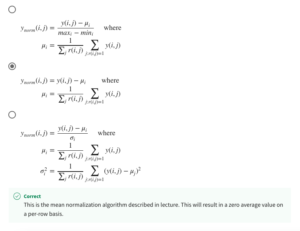unsupervised learning recommenders reinforcement learning coursera week 2 answers
Collaborative Filtering
1. You have the following table of movie ratings:

Refer to the table above for question 1 and 2. Assume numbering starts at 1 for this quiz, so the rating for Football Forever by Elissa is at (1,1) What is the value of n u
4
3. In which of the following situations will a collaborative filtering system be the most appropriate learning algorithm (compared to linear or logistic regression)?
- You subscribe to an online video streaming service, and are not satisfied with their movie suggestions. You download all your viewing for the last 10 years and rate each item. You assign each item a genre. Using your ratings and genre assignment, you learn to predict how you will rate new movies based on the genre.
- You’re an artist and hand-paint portraits for your clients. Each client gets a different portrait (of themselves) and gives you 1-5 star rating feedback, and each client purchases at most 1 portrait. You’d like to predict what rating your next customer will give you.
- You manage an online bookstore and you have the book ratings from many users. You want to learn to predict the expected sales volume (number of books sold) as a function of the average rating of a book.
- You run an online bookstore and collect the ratings of many users. You want to use this to identify what books are “similar” to each other (i.e., if a user likes a certain book, what are other books that they might also like?)
4. For recommender systems with binary labels y, which of these are reasonable ways for defining when y should be 1 for a given user j and item i? (Check all that apply.)
- y is 1 if user j purchases item i (after being shown the item)
- y is 1 if user j has not yet been shown item i by the recommendation engine
- y is 1 if user j has been shown item i by the recommendation engine
- y is 1 if user j fav/likes/clicks on item i (after being shown the item)
Recommender systems implementation
5. Lecture described using ‘mean normalization’ to do feature scaling of the ratings. What equation below best describes this algorithm?
6. The implementation of collaborative filtering utilized a custom training loop in TensorFlow. Is it true that TensorFlow always requires a custom training loop?
- Yes. TensorFlow gains flexibility by providing the user primitive operations they can combine in many ways.
- No: TensorFlow provides simplified training operations for some applications.
7. Once a model is trained, the 'distance' between features vectors gives an indication of how similar items are. The squared distance between the two vectors x (k) and x (i) is: distance x (k) −x (i) ∥ ∥ ∥ 2 =∑ l=1 n (x l (k) −x l (i) ) 2 Using the table below, find the closest item to the movie "Pies, Pies, Pies".

- Pies and You
- Pastries for Supper
8. Which of these is an example of the cold start problem? (Check all that apply.)
- A recommendation system is so computationally expensive that it causes your computer CPU to heat up, causing your computer to need to be cooled down and restarted.
- A recommendation system is unable to give accurate rating predictions for a new product that no users have rated.
- A recommendation system is unable to give accurate rating predictions for a new user that has rated few products.
- A recommendation system takes so long to train that users get bored and leave.
Content-based filtering
9. Vector x u and vector x m must be of the same dimension, where x u is the input features vector for a user (age, gender, etc.) x m is the input features vector for a movie (year, genre, etc.) True or false?
- True
- False
10. If we find that two movies, i and k, have vectors v m (i) and v m (k) that are similar to each other (i.e., ∣∣v m (i) −v m (k) ∣∣ is small), then which of the following is likely to be true? Pick the best answer.
- We should recommend to users one of these two movies, but not both.
- A user that has watched one of these two movies has probably watched the other as well.
- The two movies are similar to each other and will be liked by similar users.
- The two movies are very dissimilar.
11. Which of the following neural network configurations are valid for a content based filtering application? Please note carefully the dimensions of the neural network indicated in the diagram. Check all the options that apply:
12. You have built a recommendation system to retrieve musical pieces from a large database of music, and have an algorithm that uses separate retrieval and ranking steps. If you modify the algorithm to add more musical pieces to the retrieved list (i.e., the retrieval step returns more items), which of these are likely to happen? Check all that apply.
- The system’s response time might increase (i.e., users have to wait longer to get recommendations)
- The quality of recommendations made to users should stay the same or worsen.
- The system’s response time might decrease (i.e., users get recommendations more quickly)
- The quality of recommendations made to users should stay the same or improve.




